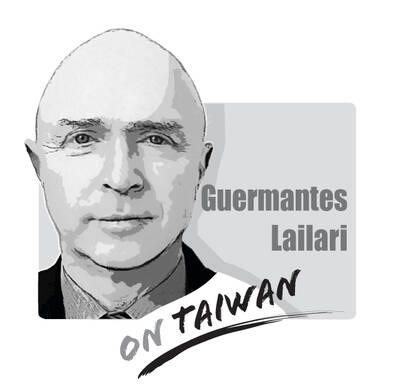The Chinese Nationalist Party (KMT) ruled the Republic of China (ROC) in China for about 22 years, from 1927, after the Northern Expedition provided some national unity to a China divided by warlords and revolution to the time it moved to Taiwan, after being thrown out of China by the Chinese Communist Party (CCP) in 1949 at the end of the Chinese Civil War.
When it came to implementing a Leninist party-state system, the CCP learned from the expert KMT.
Even today, both parties hold to the “one China” principle. The CCP sees the elimination of the ROC as unfinished business, and the KMT — and President Ma Ying-jeou (馬英九) — claims that the territory of the ROC also includes China.
In a speech at the Double Ten National Day celebrations, Ma said that cross-strait relations are not “international relations” according to the Act Governing Relations between the People of the Taiwan Area and the Mainland Area (台灣地區與大陸地區人民關係條例), and the ROC’s territory includes the Chinese mainland, according to the Constitution.
The two parties are actually “predators” of political power hiding behind the cover of Chinese nationalism.
Modern China has been through tumultuous times, from abuse at the hands of foreign colonial powers and two revolutions — the Republican revolution of 1912 and the communist revolution of 1949 — but neither regime has any respect for human life.
Democracy? Freedom? They are rhetorical names for power, and nothing else.
The political turmoil that began last month exposed the ugliness of the KMT under Ma’s rule. The KMT is desperate and is resorting to its old tricks, which means people should be wary of it. The party knows nothing about power transfers, it only knows how to run away.
Eventually, the full democratization of Taiwan will mean the end of the KMT’s party-state regime, so a few KMT leaders are planning for their future once the party loses power.
In 2002, Ma criticized former president Chen Shui-bian’s (陳水扁) proposal of “one country on each side” of the Taiwan Strait, calling it a rash move. However, that criticism exposed his ignorance of public opinion.
Ma also criticized former president Lee Teng-hui’s (李登輝) 1999 proposal of the “special state-to-state” model of cross-strait relations as a measure of expediency. Does Ma want to give Taiwan to China and surrender himself to the party-state regime on the other side?
After experiencing five direct presidential elections under the rule of Lee, Chen and Ma, the democratic system has given the antidemocratic Ma an opportunity to commandeer the fruits the nation’s development. Although he claims that he greatly respects former presidents Chiang Kai-shek (蔣介石) and Chiang Ching-kuo (蔣經國), it seems that he wants to terminate the ROC that he inherited from them. Is this the historical legacy that he is seeking?
After relocating to Taiwan 64 years ago, the ROC has failed to complete its localization with complete democratization.
Perhaps the KMT is trying to come full circle and return to China. It seeks to unite with the CCP, which also has the word “Chinese” in the party’s name.
Although the CCP ended the KMT’s rule in China, the latter’s obsession with its former home has set it on a course back to China. Since Ma has no intention of pushing for localization, expecting a pro-Taiwan KMT is wishful thinking.
After being used by Ma, those party members he is using as his puppets will eventually be abandoned.
Lee Min-yung is a poet.
Translated by Eddy Chang

Chinese state-owned companies COSCO Shipping Corporation and China Merchants have a 30 percent stake in Kaohsiung Port’s Kao Ming Container Terminal (Terminal No. 6) and COSCO leases Berths 65 and 66. It is extremely dangerous to allow Chinese companies or state-owned companies to operate critical infrastructure. Deterrence theorists are familiar with the concepts of deterrence “by punishment” and “by denial.” Deterrence by punishment threatens an aggressor with prohibitive costs (like retaliation or sanctions) that outweigh the benefits of their action, while deterrence by denial aims to make an attack so difficult that it becomes pointless. Elbridge Colby, currently serving as the Under
The Ministry of the Interior on Thursday last week said it ordered Internet service providers to block access to Chinese social media platform Xiaohongshu (小紅書, also known as RedNote in English) for a year, citing security risks and more than 1,700 alleged fraud cases on the platform since last year. The order took effect immediately, abruptly affecting more than 3 million users in Taiwan, and sparked discussions among politicians, online influencers and the public. The platform is often described as China’s version of Instagram or Pinterest, combining visual social media with e-commerce, and its users are predominantly young urban women,
Most Hong Kongers ignored the elections for its Legislative Council (LegCo) in 2021 and did so once again on Sunday. Unlike in 2021, moderate democrats who pledged their allegiance to Beijing were absent from the ballots this year. The electoral system overhaul is apparent revenge by Beijing for the democracy movement. On Sunday, the Hong Kong “patriots-only” election of the LegCo had a record-low turnout in the five geographical constituencies, with only 1.3 million people casting their ballots on the only seats that most Hong Kongers are eligible to vote for. Blank and invalid votes were up 50 percent from the previous
Japanese Prime Minister Sanae Takaichi lit a fuse the moment she declared that trouble for Taiwan means trouble for Japan. Beijing roared, Tokyo braced and like a plot twist nobody expected that early in the story, US President Donald Trump suddenly picked up the phone to talk to her. For a man who normally prefers to keep Asia guessing, the move itself was striking. What followed was even more intriguing. No one outside the room knows the exact phrasing, the tone or the diplomatic eyebrow raises exchanged, but the broad takeaway circulating among people familiar with the call was this: Trump did